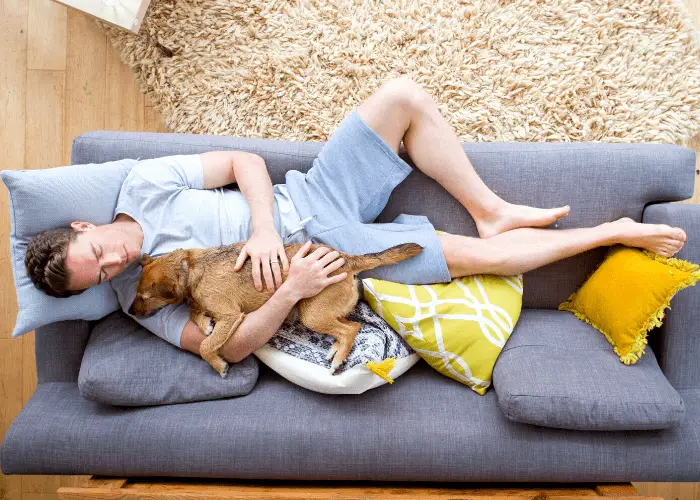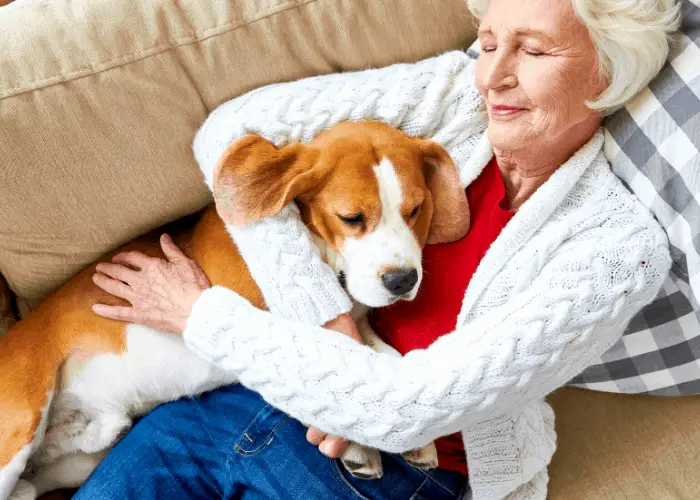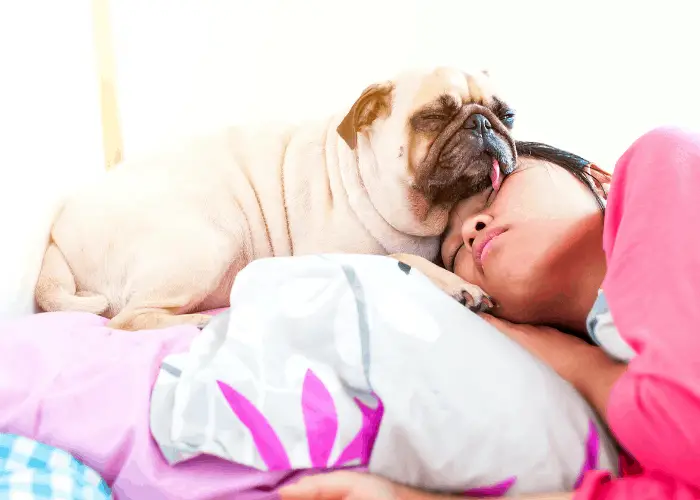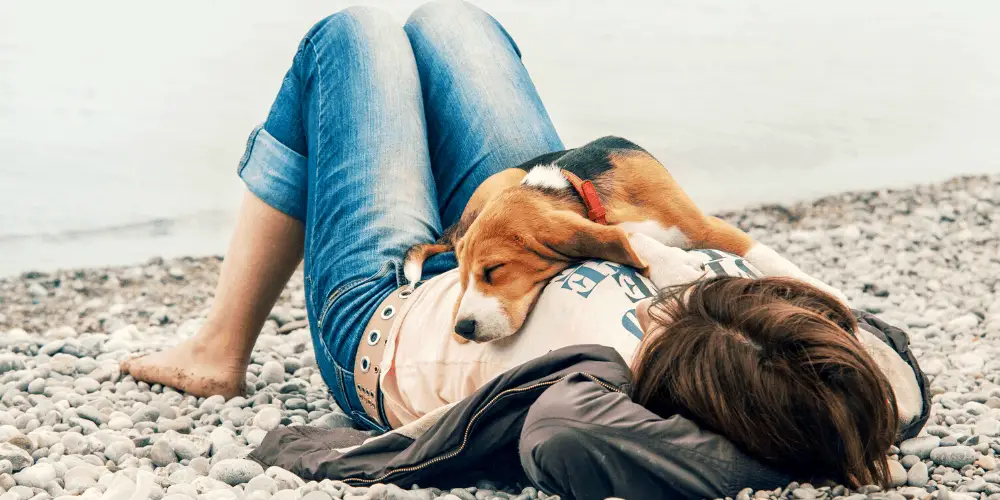Ever wondered, ‘Why does my dog lay on top of me?
You’re not alone.
This behavior, while endearing, can leave many pet owners puzzled. Rest assured; there’s more to this canine quirk than meets the eye.
As we delve into the fascinating world of dog psychology, you’ll gain a new perspective on your furry friend’s most intimate moments with you.
This understanding could help deepen your bond and enhance your pet’s parenting skills.
Let’s decode the mystery together.”
Your dog may lay on top of you for comfort, warmth, protection, love, affection, and emotional support. It could be a habit from puppyhood or a way to express their bond with you. Each dog is unique, so understanding their behavior is key to strengthening your relationship.
In this blog post, we’ll delve into the fascinating world of canine behavior and explore the factors contributing to why your dog chooses to lay on top of you.
Key Takeaways
- Dogs may lay on top of their owners to seek comfort, warmth, and security.
- They also display protective instincts by positioning themselves to keep a watchful eye.
- Laying on top of their owners is a way for dogs to show love, affection, and emotional support.
- Early habits, such as allowing puppies to sleep on you, can influence their behavior as adults.
- Training dogs to sleep in their own space is possible if desired.
- Safety precautions should be taken, especially when co-sleeping with dogs and children.
- Understanding your dog’s preferences for companionship and personal space is crucial.
- Seeking professional advice can provide additional guidance for specific concerns.
- The bond between dogs and their owners is special and should be nurtured and cherished.

When your dog curls up on top of you, seeking warmth and comfort, it’s more than snuggling.
Let’s explore the instinctual need for comfort and warmth that drives this behavior and the influence of their early experiences and expert insights.
A. Dogs seeking warmth: Imagine a chilly evening as you settle on the couch. Your loyal canine companion wastes no time in hopping up and plopping themselves on your lap or sprawling across your chest.
But why do they do it?
One of the primary reasons is their instinctual need for warmth.
As puppies snuggle up to their mother and littermates to keep cozy, adult dogs retain this behavior. They seek the warmth emitted by your body as a way to regulate their temperature. It’s their way of finding comfort and security, much like they did when they were tiny pups.
Consider the scenario of a small dog shivering from the cold. They naturally gravitate towards you, seeking solace and warmth. This behavior is adorable and a testament to their strong bond and trust with their human companion.
B. Puppyhood influence: The tendency to cuddle stems from their early experiences with their mother and littermates.
To truly understand why your dog chooses to lay on top of you, it’s essential to look back at their early experiences during puppyhood. During this critical developmental stage, puppies learn important social and survival skills from their mother and littermates.
When they were just a few weeks old, they huddled with their siblings, forming a cuddly pile to keep warm.
This close physical contact gave them the necessary warmth and a sense of security and companionship. It created a deep-rooted association between warmth, comfort, and emotional well-being.
This learned behavior carries over into their relationship with you as they age. Laying on top of you allows them to recreate the cozy atmosphere they experienced during their formative days. It serves as a reminder of the nurturing and comfort they received from their canine family.
C. Expert opinion: To shed more light on the connection between temperature regulation and cuddling behavior, let’s turn to the expertise of Dr. Stanley Coren, a renowned canine psychologist, and researcher. Dr. Coren has extensively studied dog behavior and has valuable insights to share.
According to Dr. Coren, dogs, like humans, have varying degrees of temperature regulation.
While some breeds are naturally more adapted to colder climates, others may struggle to maintain body heat. This can be especially true for small dogs or those with short coats.
When your dog chooses to lay on top of you, they use you as a source of warmth. Your body heat provides them with a cozy and comfortable spot to relax.
This behavior is deeply ingrained in their evolutionary history as pack animals, where they would huddle together for warmth and protection.
Dr. Coren’s research highlights the importance of temperature regulation in a dog’s well-being and explains why they seek warm spots, including your lap or chest.
It’s a natural and instinctual behavior that helps them maintain their body temperature and find comfort in your presence.
Picture this: It’s a frosty winter evening, and you’ve just settled down on your favorite armchair with a warm blanket.
Suddenly, your loyal furry friend jumps onto your lap and curls up, pressing their body against you.
You can feel their little paws gently kneading your legs as they find the perfect spot to snuggle.
As you stroke their soft fur, you can’t help but smile at the adorable scene. Your dog’s contentment and warmth-seeking behavior remind you of the strong bond you share and their innate need for comfort.
RELATED ARTICLE: Why Do Dogs Like Me SO MUCH?
2. Instinct to Protect:

As you snuggle up with your dog, you might notice that they seek warmth and comfort and display a protective instinct.
In this section, we’ll explore why dogs naturally gravitate towards their owners to keep a watchful eye and how physical contact provides reassurance regarding the protective nature of dogs.
A. Canine protective instincts:
Have you ever wondered why your dog always positions themselves in a way that gives them a clear view of the surroundings while lying on top of you? It’s because dogs have an innate instinct to protect their beloved human.
In the wild, canines are pack animals, relying on their pack members to navigate their surroundings and defend against potential threats.
As your loyal companion, your dog sees you as their pack leader and feels responsible for your safety.
By positioning itself on top of you, they have a vantage point from which it can keep a watchful eye on its surroundings, ensuring no harm comes your way.
This behavior showcases their protective nature and demonstrates the deep trust and bond they share with you. It’s their way of saying, “I’ve got your back, human.”
B. Physical contact for reassurance:
Regarding sleep or relaxation, dogs often lie on top of their owners to seek reassurance and security. Their physical contact provides comfort and safety that allows them to relax fully.
Just as a child seeks their parent’s embrace for a goodnight’s sleep, dogs also find solace in being close to their trusted human companion.
The warmth of your body and the rhythmic rise and fall of your chest as you breathe all create a soothing environment for your dog to unwind.
Your dog feels a profound connection and emotional support by laying on top of you. It’s their way of finding peace in your presence and comfort in knowing you are there for them.
3. Love and Affection

There’s something truly special about how dogs shower their owners with love and affection.
When your furry friend chooses to lay on top of you, it goes beyond seeking comfort or protection—it’s a heartfelt expression of their unwavering devotion.
Unconditional love:
If you’ve ever doubted the capacity for unconditional love, look no further than your four-legged companion. Dogs have an innate ability to form deep emotional bonds with their owners, surpassing any boundaries or conditions. Their love is pure, genuine, and unwavering.
When your dog chooses to lay on top of you, it displays affection and a desire for closeness. In their eyes, you are their world, and physical contact with you brings them immense joy and contentment.
Whether you’ve had a rough day or need emotional support, your dog senses your needs and provides the comfort you seek through its loving presence.
The significance of physical touch:
A physical touch is a powerful form of communication, and dogs excel at expressing their emotions through it. When your dog curls up on top of you, they seek physical warmth and use their bodies to convey their love and adoration.
Through snuggling, your dog says, “I cherish you, and I want to be as close to you as possible.”
The gentle pressure of their body against yours is their way of establishing a deep connection and reminding you of their unwavering loyalty. It’s their version of a warm hug, a silent declaration of their affection that transcends words.
4. Emotional Support:

Dogs are not just companions; they also rely on us for emotional support. When your dog chooses to lay on top of you, it’s a sign that they seek comfort, security, and reassurance from your presence.
In this section, we’ll explore the emotional well-being of dogs, the role laying on top of you plays in providing anxiety and stress relief, and offer expert advice on providing emotional support to your furry friend.
The emotional well-being of dogs:
Like humans, dogs have emotional needs that require fulfillment for their well-being. They thrive in environments that offer comfort, security, and emotional support. Your dog sees you as their trusted confidant and seeks solace in your company.
When your dog lays on top of you, it indicates that they trust you to provide the emotional support they need.
They find comfort in the familiar scent, the sound of your heartbeat, and the sense of safety that your presence brings. Your dog knows that with you, they are in a secure and loving environment where their emotional needs are met.
Anxiety and stress relief:
Anxiety and stress can affect dogs just as they do humans. However, dogs may not have the same ability to communicate their feelings verbally. Instead, they rely on non-verbal cues and behaviors to express their emotions.
Laying on top of you can be a powerful coping mechanism for dogs experiencing anxiety or stress. The physical contact with you provides a sense of security, calming their nerves and soothing their anxious minds.
Your body’s warmth and steady heartbeat are comforting, helping them feel safe and protected in times of distress.
The act of snuggling on top of you not only provides immediate relief but also establishes a positive association for future situations. Your dog learns that being close to you brings comfort and eases anxiety, reinforcing your emotional bond.
Tips for providing emotional support to your furry friend.
To ensure you’re providing the best possible emotional support for your dog, consider the following expert tips:
- Create a safe space: Set up a designated area where your dog can retreat to when they need some alone time or feel overwhelmed. Provide comfortable bedding, toys, and a calming atmosphere.
- Maintain a routine: Dogs thrive on routine and predictability. Establish a consistent schedule for feeding, exercise, and playtime, as this helps them feel secure and reduces anxiety.
- Engage in interactive activities: Regular mental and physical stimulation through games, puzzles, and training exercises can boost your dog’s confidence and provide a sense of accomplishment.
- Practice positive reinforcement: Reward your dog with praise, treats, and affection when they exhibit calm and relaxed behaviors. This encourages positive associations and reinforces their emotional well-being.
- Consider professional help: If your dog consistently exhibits signs of anxiety or stress despite your best efforts, consult a professional, such as a veterinarian or a certified animal behaviorist, who can provide tailored guidance and support.
Remember, every dog is unique, and their emotional needs may vary. Pay close attention to their body language and behaviors to gauge their well-being and adjust your approach accordingly.
You can provide your dog’s emotional support to thrive by offering expert advice and practical tips.
Understanding their emotional well-being and the role laying on top of you plays in providing comfort and relief will strengthen your bond and ensure a happy and fulfilled canine companion.
5. Habit Formation:

The habits formed during a dog’s early years can impact its behavior as they grow into adulthood. When it comes to laying on top of you, their preferences and habits play a significant role.
In this section, we’ll explore the influence of allowing your dog to sleep on you during their puppy years, provide tips and techniques for breaking the habit, and help you understand your dog’s preferences for companionship and personal space.
Early habits:
Exploring the influence of allowing your dog to sleep on you during their puppy years.
When you first welcomed your furry friend into your home as a puppy, their adorable size and cuddliness might have prompted you to let them sleep on you.
While it’s undoubtedly an endearing experience, it’s important to recognize the impact these early habits can have on their behavior as they mature.
Allowing your puppy to sleep on you creates a sense of comfort, warmth, and security.
It mimics the closeness they experienced with their mother and littermates, providing a familiar environment. However, it’s crucial to balance bonding with your puppy and ensuring they develop healthy, independent behaviors.
Understanding the influence of early habits allows you to make informed decisions about encouraging or discouraging certain behaviors, including laying on top of you as you grow older.
Breaking the habit:
If your dog’s habit of laying on top of you has become overwhelming or disruptive, it’s possible to train them to sleep in their own space. Here are some tips and techniques to help break the habit:
- Create a comfortable space: Designate a specific area for your dog’s sleep, such as a cozy bed or crate. Make it inviting by adding familiar scents, soft bedding, and toys.
- Establish a bedtime routine: Create a consistent routine that signals bedtime for your dog. This can include walking, brushing your teeth, or playing calming games. Consistency helps your dog understand when it’s time to relax and sleep.
- Use positive reinforcement: Encourage your dog to go to their designated sleep space by rewarding them with treats, praise, or favorite toys. Make it a positive experience that they associate with their sleeping area.
- Gradual transition: If your dog is used to sleeping on you, gradually transition them to their own space. Start by allowing them to sleep on a nearby bed or mat, then gradually move it farther away until they are comfortable sleeping in their designated area.
- Be patient and consistent: Breaking a habit takes time and patience. Stick to the training routine consistently, and don’t get discouraged if progress is slow. With perseverance, your dog will learn to sleep in their own space.
Understanding your dog’s preferences:
While it’s important to establish boundaries and train your dog to sleep in its own space, it’s equally important to understand their preferences for companionship and personal space.
Dogs, like humans, have individual personalities and comfort levels regarding physical contact.
Please pay attention to your dog’s body language and cues to determine when they genuinely enjoy your company, seek closeness, and need personal space.
Respect their boundaries and allow them to choose their preferred sleeping spot. Remember that some dogs may naturally be more independent and prefer their space, while others thrive on close physical contact.
By recognizing and respecting your dog’s preferences, you can balance providing companionship and ensuring they have the freedom to establish their personal space.
Understanding the influence of early habits, implementing effective training techniques, and recognizing your dog’s preferences will help you transition from allowing your dog to sleep on you to encouraging them to sleep in their own space.
It’s a process that requires patience, consistency, and a deep understanding of your dog’s individual needs and behaviors.
Ensuring Safety: Precautions and Considerations

While co-sleeping with your dog can be a heartwarming experience, it’s essential to prioritize safety, especially when children are involved.
In this section, we’ll discuss important safety measures to follow when co-sleeping with your dog, the significance of supervision and awareness, and provide insights from veterinarians and child safety experts on co-sleeping with pets.
Safety measures:
Co-sleeping with your dog can be a delightful way to bond, but it’s crucial to establish safety guidelines, especially when children share the sleeping space. Consider the following measures to ensure a safe co-sleeping environment:
- Set boundaries: Establish clear boundaries for your dog’s sleeping area, whether on the bed or in a designated spot nearby. Teach your dog to respect these boundaries and reinforce them consistently.
- Size and temperament: Consider your dog’s size and temperament when deciding whether it can safely co-sleep. Large or rambunctious dogs may inadvertently pose a risk to young children, so it’s important to assess their behavior and interactions carefully.
- Teach appropriate behavior: Train your dog to be calm and gentle in bed. Discourage jumping, rough play, or any behaviors that could harm you or your child during sleep.
- Provide separate sleeping spaces: If you have safety concerns, consider providing your dog with a comfortable sleeping space, such as a crate or a dog bed in the same room. This ensures everyone has their own area for uninterrupted rest.
Supervision and awareness:
When co-sleeping with your dog, it’s crucial to maintain supervision and be aware of potential risks. While generally loving and gentle, dogs can inadvertently cause harm, particularly when startled or uncomfortable. Consider the following precautions:
- Supervise interactions: Always supervise interactions between your dog and children while co-sleeping. Be vigilant and intervene if any signs of discomfort or potential issues arise.
- Teach gentle touch: Educate children on how to interact gently and respectfully with the dog during sleep. Encourage them to avoid sudden movements or disturbing the dog’s rest.
- Monitor sleeping arrangements: Regularly assess the dynamics of co-sleeping and ensure that everyone has enough space to rest comfortably without overcrowding. This helps prevent accidental injuries or discomfort.
- Maintain open communication: Talk to your children about respecting the dog’s space and boundaries. Encourage them to communicate any concerns or discomfort they may experience.
By following safety measures, maintaining supervision, and seeking expert guidance, you can create a safe co-sleeping environment for your dog and your family.
Prioritizing safety ensures everyone can enjoy the benefits of co-sleeping while minimizing potential risks and promoting harmony in the sleeping space.
WORTH A LOOK:
Conclusion

Throughout this blog post, we’ve explored why your dog chooses to lay on top of you, uncovering the fascinating behaviors and instincts behind this adorable act of affection.
We discussed how dogs seek comfort and warmth from your body, display their protective instincts, show their love and affection, seek emotional support, and sometimes continue the habit from puppyhood into adulthood.
Additionally, we addressed the importance of considering safety precautions, breaking habits when necessary, and understanding your dog’s preferences for companionship and personal space.
The bond between you and your dog is a truly special connection. Their choice to lay on top of you is a testament to the depth of this bond and their unwavering love and loyalty.
Understanding the reasons behind their behavior can help strengthen your relationship and create a harmonious living environment.
By recognizing your dog’s instinctual needs, emotional support, and individual preferences, you can give them the love, care, and companionship they need to thrive.
Remembering that every dog is unique and adapting to their specific needs and behaviors is crucial.
We would love to hear about your experiences with your furry friend and their snuggling habits.
Feel free to share your stories, anecdotes, and insights in the comments section.
Additionally, suppose you have any specific concerns or questions regarding your dog’s behavior.
It’s always a good idea to consult a professional, such as a veterinarian or a certified animal behaviorist.
They can provide tailored guidance and support based on your dog’s needs.
Remember, your love and affection for your dog are unique and irreplaceable.
Cherish the moments of snuggling and closeness, and continue to nurture the bond that makes your relationship with your furry companion so special.
REFERENCES:
1. Dog behavior. (2023, May 18). In Wikipedia. https://en.wikipedia.org/wiki/Dog_behavior
2. Merola, I., Prato-Previde, E., & Marshall-Pescini, S. (2012). Dogs’ Social Referencing towards Owners and Strangers. PLOS ONE, 7(10), e47653. https://doi.org/10.1371/journal.pone.0047653


